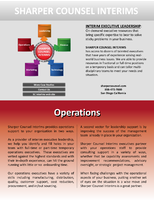Two ASTM Nanotechnology Standards have been adopted by FDA.
Press Release Summary:
U.S. FDA added two ASTM International standards to its List of Recognized Standards. These are E2490: Guide for Measurement of Particle Size Distribution of Nanomaterials in Suspension by Photon Correlation Spectroscopy, and E2535: Guide for Handling Unbound Engineered Nanoscale Particles in Occupational Settings. Guide for Detection and Characterization of Manufactured Silver Nanomaterials in Textiles (WK37636) is in development by ASTM's Nanotechnology Committee (E56).
Original Press Release:
U.S. FDA Adopts Two ASTM International Nanotechnology Standards
Additional Standard on Silver Nanomaterials Underway
W. CONSHOHOCKEN, Pa. — The U.S. Food and Drug Administration has added two ASTM International standards to its List of Recognized Standards, meaning that the FDA advises referring to listed documents for points to consider when assessing whether an FDA-regulated product involves the application of nanotechnology.
Specifically, ASTM recently published a standard that describes one of the few techniques that measure particle size distribution in the nano-size region (E2490: Guide for Measurement of Particle Size Distribution of Nanomaterials in Suspension by Photon Correlation Spectroscopy). This standard was developed by ASTM Subcommittee E56.02 on Physical and Chemical Characterization.
The second FDA-recognized standard describes how to handle unbound nanoscale particles in settings ranging from manufacturing to research and development (E2535: Guide for Handling Unbound Engineered Nanoscale Particles in Occupational Settings). This standard was developed by Subcommittee E56.03 on Environment, Health and Safety.
In addition, ASTM’s Nanotechnology Committee (E56) is now developing a standard entitled Guide for Detection and Characterization of Manufactured Silver Nanomaterials in Textiles (WK37636). The standard will provide methods, operating principles and a discussion of advantages and limitations in regards to silver nanomaterials in clothing.
According to ASTM member Aleksandr Stefaniak, silver has been used as an antimicrobial, antifungal and antiviral compound for centuries. Many consumer products, particularly clothing, now incorporate silver nanomaterials. Both natural and synthetic fibers can contain silver and it is even being incorporated into leather fibers. Other unique uses of silver nanomaterials in textiles include wet wipes that hunters use on their skin to eliminate odor that might scare game.
“There is broad recognition that there are many types of silver used in textiles and that they are applied to fibers in many different ways,” says Stefaniak, who works for the National Institute for Occupational Safety and Health. “However, there is little agreement on the best approach to determine if a textile contains silver and, if it does, whether it is a nanomaterial. Anyone involved in textiles — from production through the end of a product’s lifecycle — will benefit from this standard.”
The proposed standard could have broad applications. Companies that produce textiles with silver will use the standard to ensure products meet quality control requirements. Garment makers will use the standard to ensure that their suppliers provide textiles that meet requirements. And regulators will use the standard to determine if a product under their jurisdiction contains silver in the form of a nanomaterial.
All interested parties are invited to join in the development of nanotechnology standards at ASTM.
To purchase standards, visit www.astm.org and search by the standard designation, or contact ASTM Customer Relations (tel +1.877.909.ASTM; sales@astm.org). ASTM welcomes participation in the development of its standards. Become a member at www.astm.org/JOIN.
Helping our world work better
Over 12,000 ASTM standards operate globally. Defined and set by us, they improve the lives of millions every day. Combined with our innovative business services, they enhance performance and help everyone have confidence in the things they buy and use – from the toy in a child’s hand to the aircraft overhead.
Working across borders, disciplines, and industries we harness the expertise of over 30,000 members to create consensus and improve performance in manufacturing and materials, products and processes, systems and services. Understanding commercial needs and consumer priorities, we touch every part of everyday life: helping our world work better.
For more news in this sector, visit www.astm.org/sn-metals.
ASTM Committee E56 on Nanotechnology Next Meeting: April 9-10, National Institute for Standards and Technology, Gaithersburg, Md.
Media Inquiries:
Nathan Osburn
tel +1.610.832.9603
nosburn@astm.org
Technical Contact:
Aleksandr Stefaniak
NIOSH
Morgantown, W.V.
tel +1.304.285.6302
Boq9@cdc.gov
ASTM Staff Contact:
Kathleen McClung
tel +1.610.832.9717
kmcclung@astm.org




